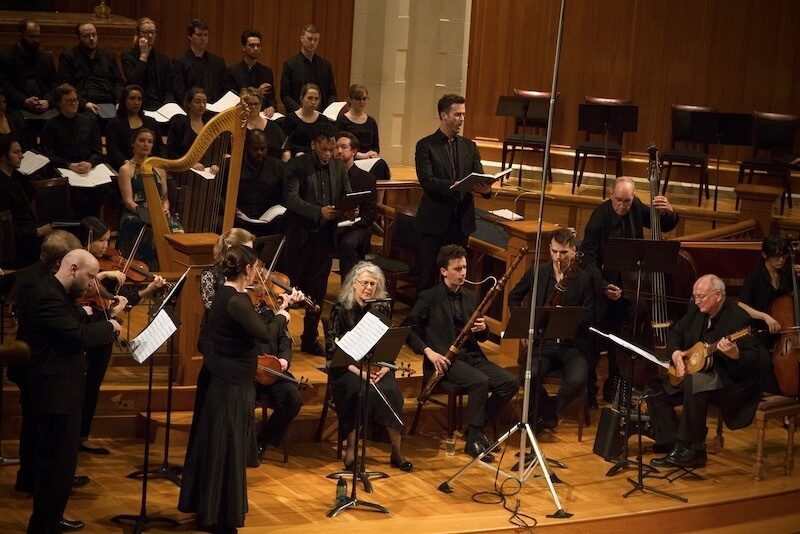What Do We Take With Us?
Review of Samson by Pacific MusicWorks.
Written by TeenTix Newsroom Writer Spencer Klein, and edited by Teen Editor Anya Shukla!

George Frideric Handel was born the same year as Bach: 1685. He was a German composer, though he travelled around all of Europe, and is most notorious for the oft-overused Hallelujah Chorus from The Messiah (see the opening of Face Off). While Handel’s innovations in composition were important, they are drastically overshadowed by the revolutionary achievements of Bach. Handel’s contribution to music came in a much more subtle, but equally radical fashion: he made music a business.
Handel found great success in Italian opera; in 1705 he debuted the instant hit Almira and his influence only grew. The problem with Italian opera, however, was that it was both expensive and exclusive. The costumes are elaborate and few opera-goers in his adopted homeland of England spoke Italian. To solve these problems, Handel renovated and popularized the Oratorio, essentially an unstaged opera. Instead of blocking, singers simply stand up when it is their cue. Featuring mostly liturgical plots, Oratorios became vastly popular because of their relatively low cost to perform and the fact that they are sung in English.
That’s the first thing one should know about this Oratorio: as beautiful as it may be, it is long. Samson, performed by Pacific MusicWorks, followed The Messiah in the Händel-Werke-Verzeichnis (the catalogue of Handel’s works) with the following plot: Samson is a blind slave who pulls down a Philistine temple, killing both himself and a bunch of Philistines. Speaking to the plot is difficult since it’s based on the Old Testament, but the action takes ages to unfold. For example, Samson challenges a giant to a fight, and the giant says no, an event that occupies half of an hour-long act. Beauty, however, is omnipresent. Soaring, crystalline voices filled Seattle’s First Baptist Church. Unfortunately, this beauty does not have enough staying power to keep listeners engaged for three hours.
The joking catchphrase of baroque music, of which Samson is an example, in the musicology world is “set it and forget it.” Dynamic contrast, tempo changes within movements, and crescendi were all innovations unbeknownst to the baroque period. Meaning, of course, they are equally unbeknownst to Samson, leaving for a musical narrative that struggles to find expression within its medium. When you add 17 “Airs” (baroque arias), all of which repeat themselves several times over, Samson drags its feet. Melodically these airs are super interesting, especially with the virtuosic ornamentation added by the talented cast. Unfortunately, the air format involves repeating the same four lyrics for seven minutes, and it gets borderline irritating. (Imagine “Surfin Bird” but at a much slower tempo.)
There is something to be said for Pacific MusicWorks’ historical accuracy. All of the instruments in the orchestra were period accurate; oboes and bassoons without keys, stringed instruments with arched bows and a valveless brass section. However, this accuracy comes at a cost: baroque stringed instruments lack the precise tuning apparatus that comes standard to those made in the classical era. The orchestra was outstanding, but because of these technological shortcomings, it lacked the clarity and glimmer of a modern orchestra.
All of the flaws in this performance have one thing in common: they are not the fault of Pacific MusicWorks. By all means, the company put on a beautiful, historically correct Oratorio. The problem lies in the format itself. Which brings us to the question central to this review: What do we take with us from the past? Probably the better question to ask is what parts do we take with us? Dozens of operas have been updated and set in modern or politically relevant settings (for an example, check out Carmen, set in Communist Cuba, at Seattle Opera). Shakespeare productions have been revamped all over the country to reach a wider audience. Somehow, these adaptations manage to keep the spirit of the original production while maintaining relevancy. It’s time for Oratorios to do the same.
Lead photo caption: Samson by Pacific MusicWorks. Photo by Anjani Millet.
The Teen Editorial Staff is made up of 5 teens who curate the review portion of the TeenTix blog and manage the TeenTix Newsroom. More information about the Teen Editorial Staff can be found HERE.
The TeenTix Press Corps promotes critical thinking, communication, and information literacy through criticism and journalism practice for teens. For more information about the Press Corps program see HERE.


